Original Apple iMac
Greetings, habrazhiteli! I want to tell you about the computer that gave a new, powerful impetus to the development of such a branch of computers as AIO, or our monoblocks. We will talk about the original iMac, which was released in 1998.
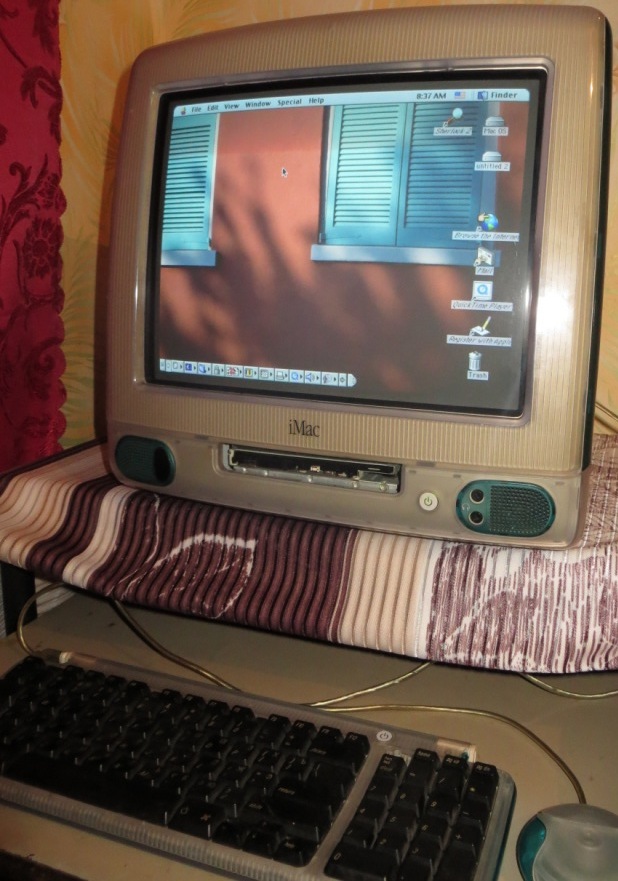
In 1996, when Apple steadily rolled into the abyss, it was decided to seek salvation in the form of other companies with unique innovative developments. The choice was between Be Inc. and NeXT Software Inc. The Be deal failed because Jean-Louis Gassier requested $ 200 million while Apple counted on only $ 125 million. The Apple company had no choice but to negotiate the purchase of NeXT. The transaction took place and the decision of the board of directors Steve Jobs became the CEO of Apple. Remarkably, in 1985, Gassier replaced Jobs who had left Apple as the leader of the Macintosh division. Thus, both bidding firms were founded by people from Apple.
Rising at the helm of Apple, Jobs began an aggressive policy of leading the company out of crisis. One of the measures was the development of a fundamentally new Macintosh, not like previous generations. As a result, this wonderful, once cult computer appeared, which was the personification of style, convenience and quality in the world of high technologies. It was that fresh breeze that blew away the bored gray and square of previous generations of Macintoshes.
')
So, the computer that many probably saw in youth or childhood in pictures, the original iMac, was produced only in a dark turquoise color, with an opaque body. In the future, the body was made transparent, and the color palette expanded significantly. The original iMac was equipped with a motherboard of one of two revisions - A and B. The difference was in the maximum amount of RAM that could be installed, a more powerful video chip and more video memory in revision B. Also, one of the main differences from other generations of the iMac was the CD- ROM. It was a conventional laptop drive with a sliding disc tray. Subsequent versions were equipped with drives with a slot-loading disk.
The design of this computer was developed by Jonathan Ive. It has rounded smooth shapes, almost no sharp lines are observed anywhere. The lower part of the monoblock is made of translucent gray plastic. The front panel is made of the same plastic, only with the addition of vertical edges. The upper part of the case is also made of a dark turquoise translucent plastic. On top there is a ventilation grille, in the middle of which is mounted a handle for carrying a computer. By the way, it is very useful, since the iMac weighs almost 16 kg. In addition, on eBay, you can order a glass tabletop, which will turn the iMac into an original table.

IMac has some interesting solutions. For example Foldable leg, which allows you to raise the computer if it is too low.
With leg:

Without legs:
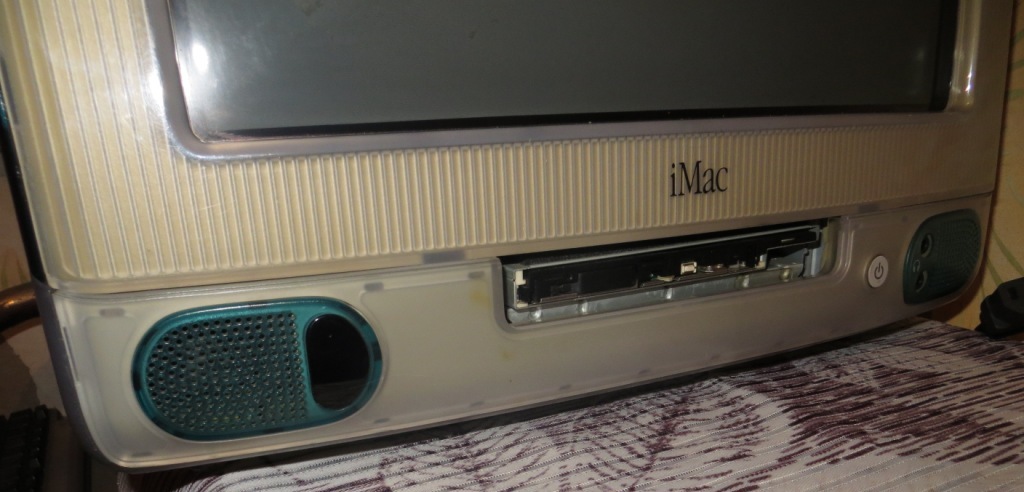
Also, an interface block is made interesting. It is closed with a hinged lid with a hole into which the wires are passed. In subsequent versions of iMac, the connector panel is completely open.
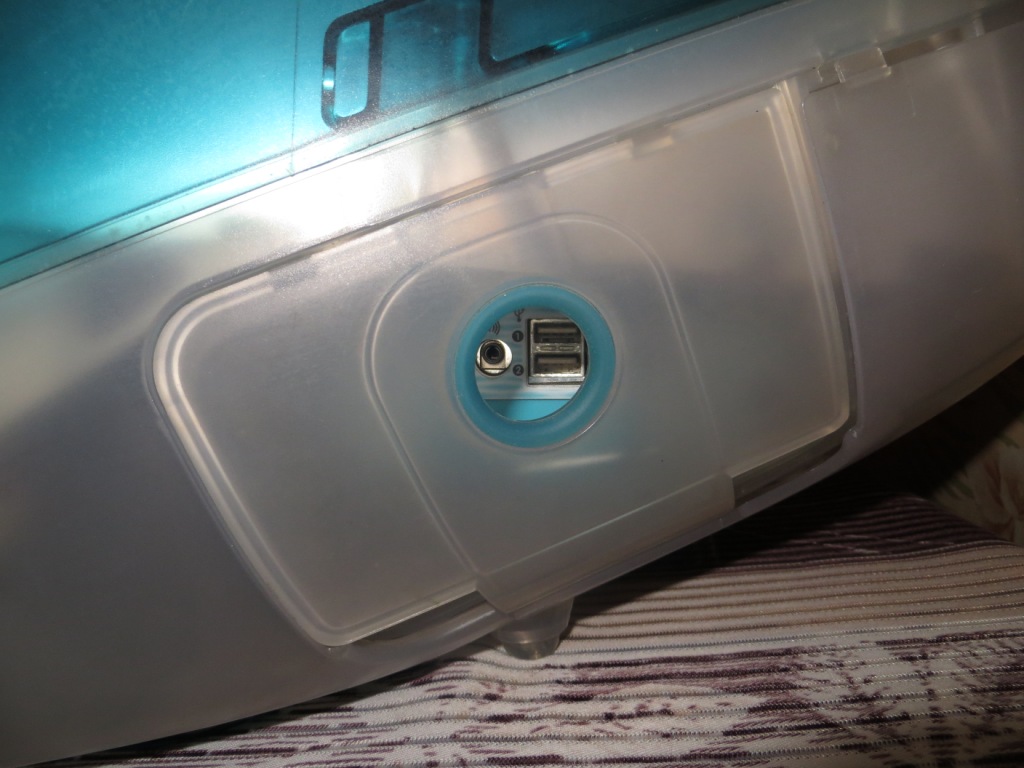
My copy came into my hands from the owner of one small Krasnoyarsk printing house, in which it had previously been used for layout and has recently done color matching (not strong in terms, but the former owner explained this). I found it on some bulletin board. I phoned the seller and went to Krasnoyarsk. Having met at the Opera and Ballet Theater, he gave the owner 1,500 ever-wooden ones, which he asked for a box with a computer, and went home with the purchase. I must say that the purpose of the purchase was pretty stupid - to feel the technique of Apple, which is so much praised. In my city to work on a poppy and even more so to buy Apple products was not possible. Then I decided to fuck eBay. I even stopped at one iMac G4 (iLamp) but stopped the cost of delivery, which was twice its price.
A little familiar with the appearance, you can look inside.
iMac is a monoblock, in the upper part of which are located: a kinescope, a video signal processing board and a power supply unit. At the bottom are: motherboard, optical drive, hard drive, speakers, infrared. The top and the bottom of the monoblock are separated by a metal mesh partition, which serves as a screen protecting the motherboard from interference and interference from the power supply and scan modules.
Access to electronics is closed by a plastic translucent cover, which is held by one screw (I did not have one). It is removed quite nontrivially and noisy.
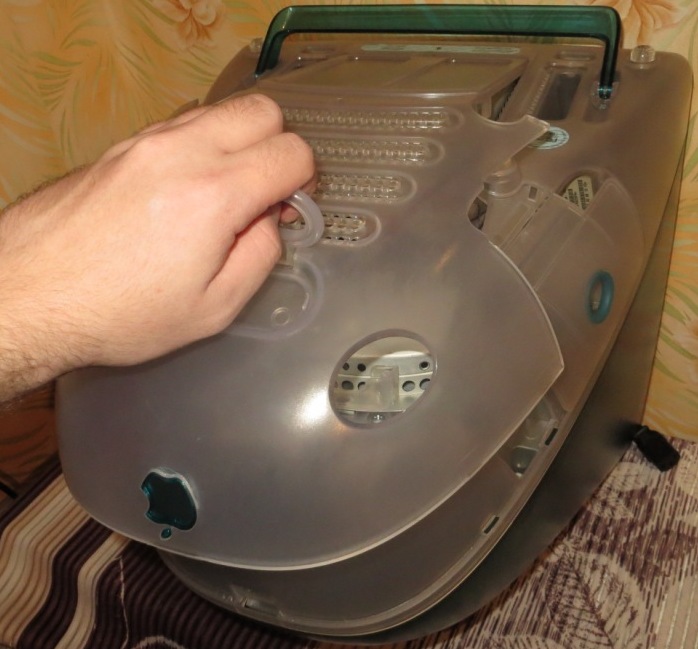
It is necessary to take the handle and pull up and back. With a loud sound, the cover is separated from the case and remains hanging in the hand. We remove it.
The computer part of the iMac is located in a sort of cup-sled which, after unscrewing the two screws and disconnecting the plugs, is pushed back.
Let us consider the result of the preparation.
Below we see the CD-ROM, just above, in fact, the motherboard.
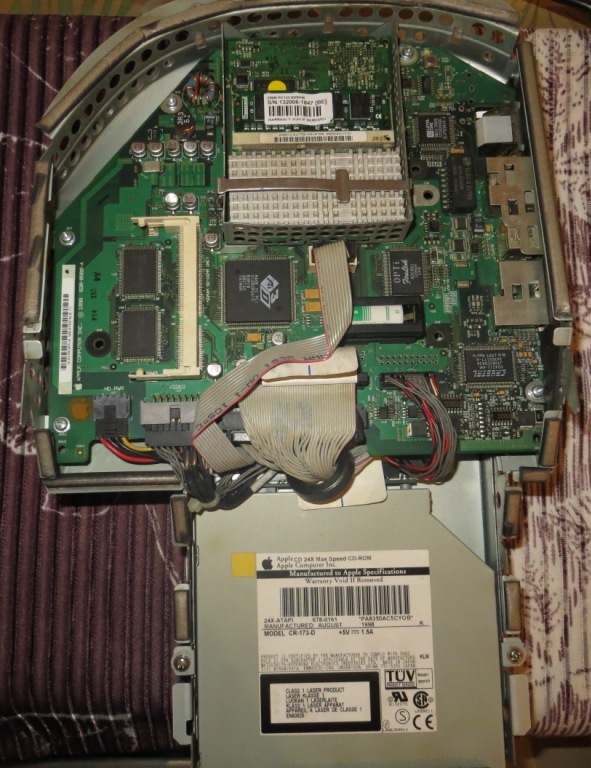
Here you can see the graphics chip Ati Rage IIc and 2MB SGRAM soldered on the board, the white SO-DIMM connector is designed to expand the amount of video memory with the SO-DIMM SGRAM bar. In total, you can have up to 6MB of video memory.
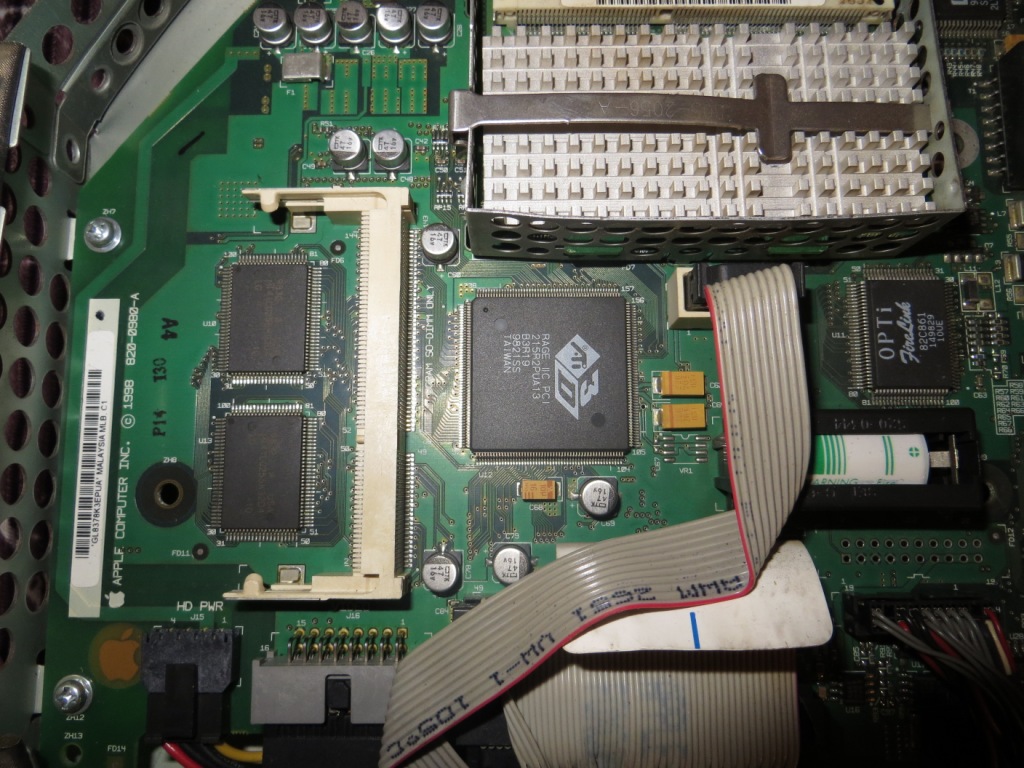
Next, you can consider the Crystal 4211 sound processor, a Li-ion battery for saving OpenFirmware parameters, and a FireLink network controller.
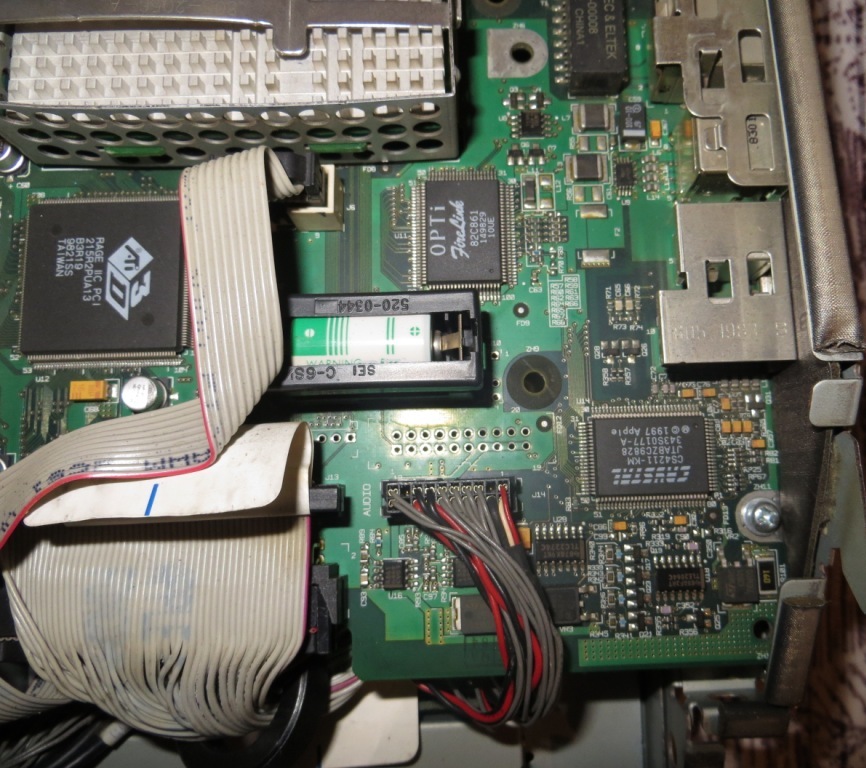
Well, the most important part - the processor and RAM. The radiator has already been removed from the processor. Next, as I understood it, the cache is soldered, if not, correct it. It is characteristic that the processor and RAM are on a separate board that “sits” on the motherboard. Memory slots are located one on each side. Just above the processor, you can see the 256MB SO-DIMM SDRAM module.

For reasons unknown to me, he sees it in half. Initially, there were 2 modules of 64MB in it, however, he saw 96MB. Experienced by, I found out what bar he sees completely and which half. When I bought the bar at 256MB I really hoped that she would see her completely. However, my hopes were broken when I saw in the information about the poppy that 128MB RAM is available. Then I added a 64MB bar to the second slot which was completely visible. Total out 192 MB. MacOS 9 just flew even at 96MB, and even on such a volume ... However, when preparing the article, it turned out an unpleasant detail. When turned on, the poppy issued a heart-rending creak from the speakers and refused to start. I was really upset that my little son was flooded with something, but later I tried to take out one memory module. Unfortunately, it turned out that this 64MB bracket had died and was replaced by a 64MB module but which is seen in half. Total now it has 160 MB of RAM. In principle, you can run MacOS X10.3.9, but it crawled leisurely, even with 192 MB of RAM.
Dead cause for confusion.

The processor is Motorola XPC750, model 750 PowerPC architecture, with a clock frequency of 233 MHz. Cooled by a small aluminum radiator.


View of the motherboard without a processor card
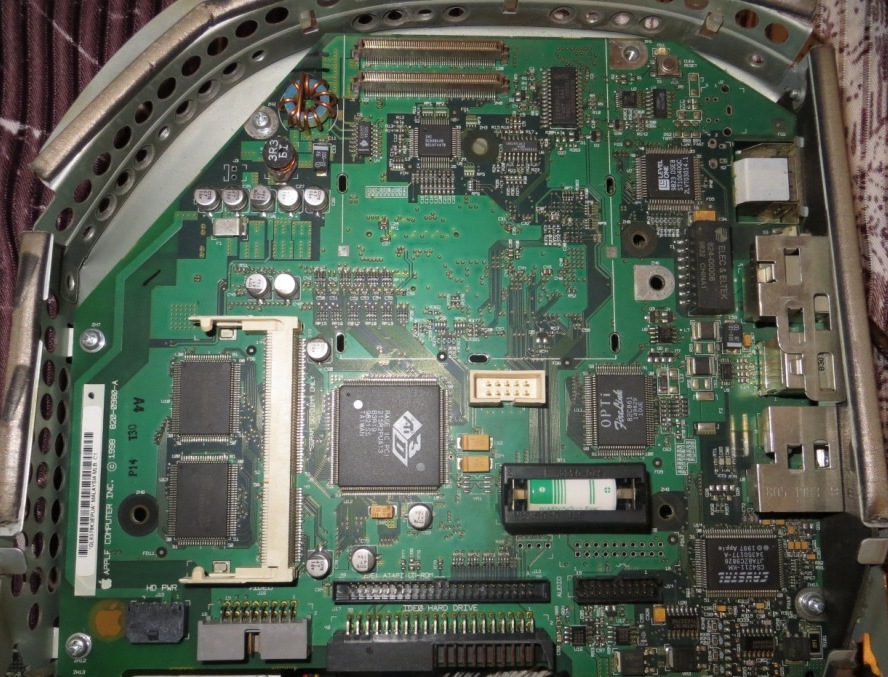
The hard drive was originally a 4GB Quantum Fireball, and with it I got the poppy. However, a month later I noticed a strong inhibition and freezes. And after a while I tried to reinstall the OS, and the installation hung when accessing the disk. To confirm my suspicions about the hard drive, I checked his MHDD on another machine. No matter how sad, but instead of gray cubes crosses stubbornly fell on the table. I had to get out of the bins of the old Seagate 40GB.
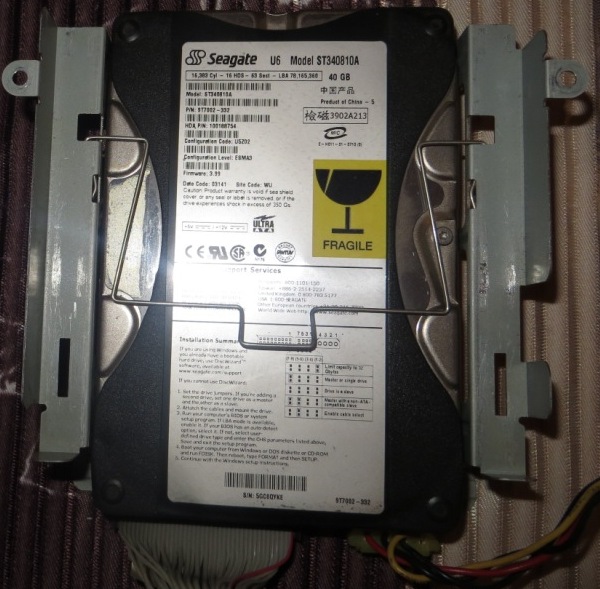
And here is the CD-ROM, judging by the label, it was made by Apple, according to Apple specifications for Apple. In fact, released by Matsushita.
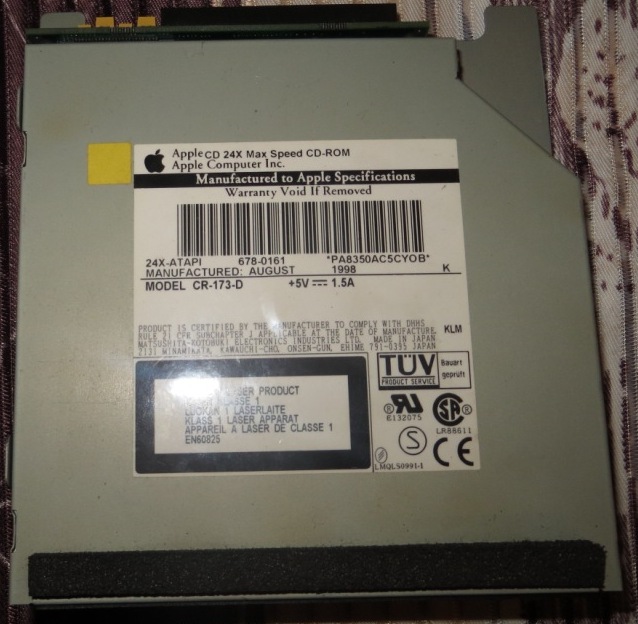
At the end of the drive tray should be a cap in the color of the case. There is a cap, but I could not find it after my son got access to the iMac.
Now, when plenty of admire the inside, you can assemble a computer and turn it on.
We return the computer part to the former view:

View of the case without a computer part. The fan is the only one in the whole structure. It blows the processor module, drawing in air through the lower lattice of the case, and blows it into the upper part, thus cooling also the power supply unit with the monitor.
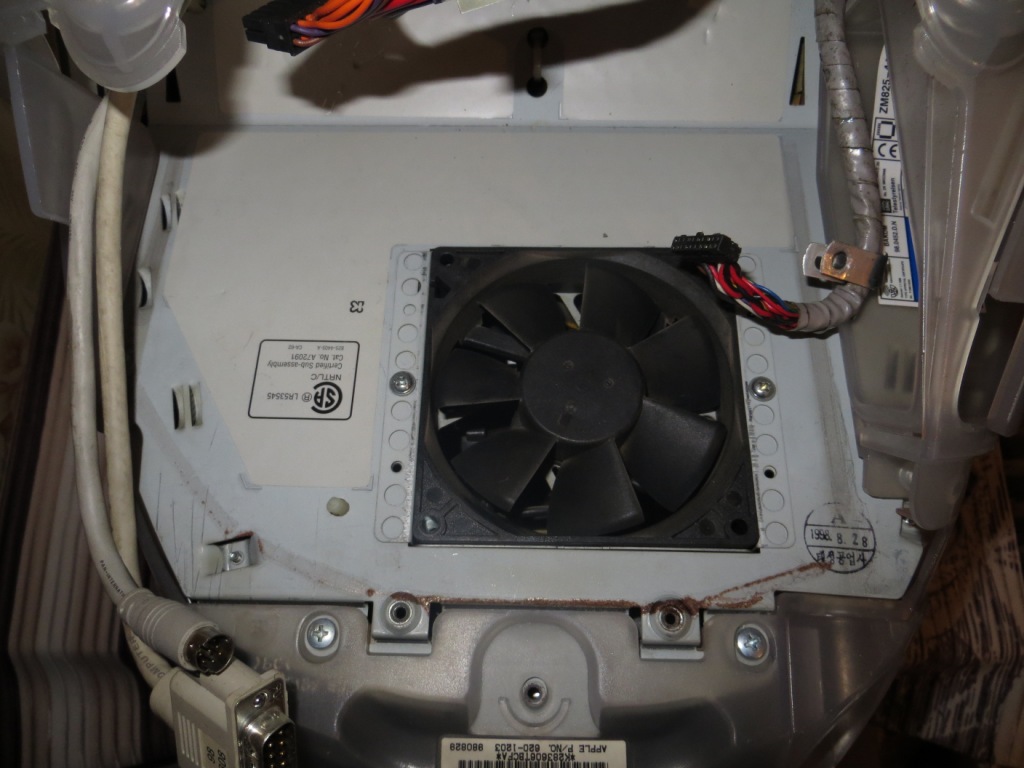
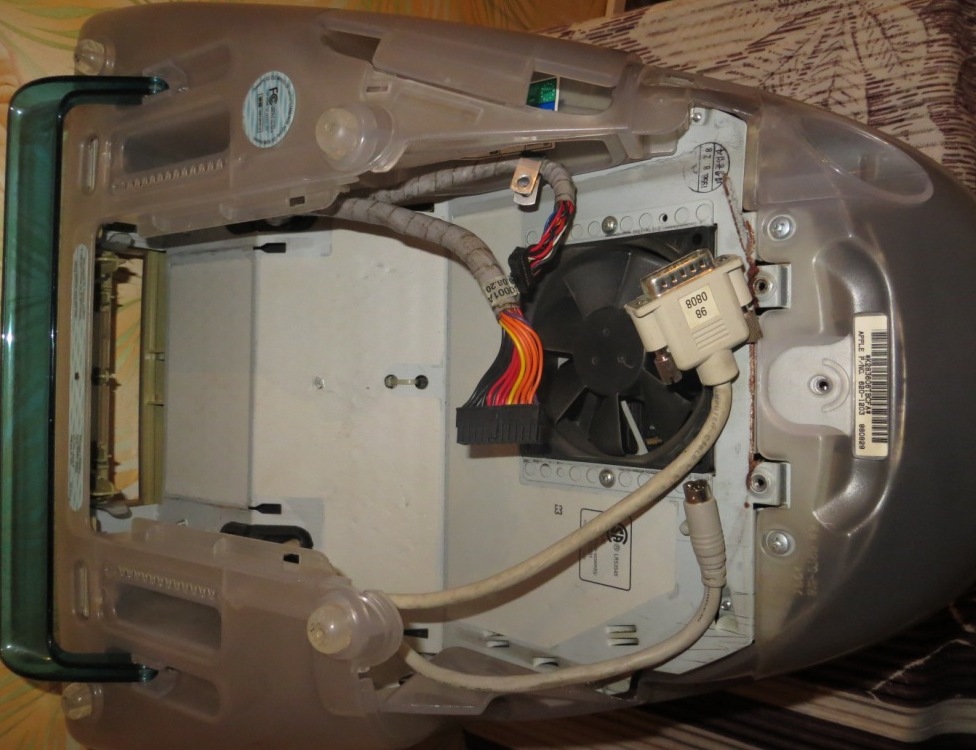
The wires from the top of the withdrawn through the rubber ... bushings, that is.


All assembled. It remains only to wear a cap.

The interfaces for the original iMac are as follows (from left to right):
Microphone jack, headphone jack, two USB1.1 jacks, network adapter jack, hidden “cold reset” buttons and, if the OpenFirmware settings reset memory does not change me. And the extreme right is the telephone line jack for the internal modem, which by the way is V.92, which is very good for those years. The cap at the bottom was supposed to be a SCSI connector, but apparently changed their mind at the last moment.

As many probably noticed, there is no FireWire port. On subsequent versions, it has already been entered. However, there was an unofficial way to screw the FireWire port to the original iMac, for the subsequent installation of MacOS X 10.4 - the Harmoni card-accelerator. It had a FireWire controller, a faster G3 500 processor and slots for RAM. It was installed instead of the standard processor board. However, to find it now is unreal.
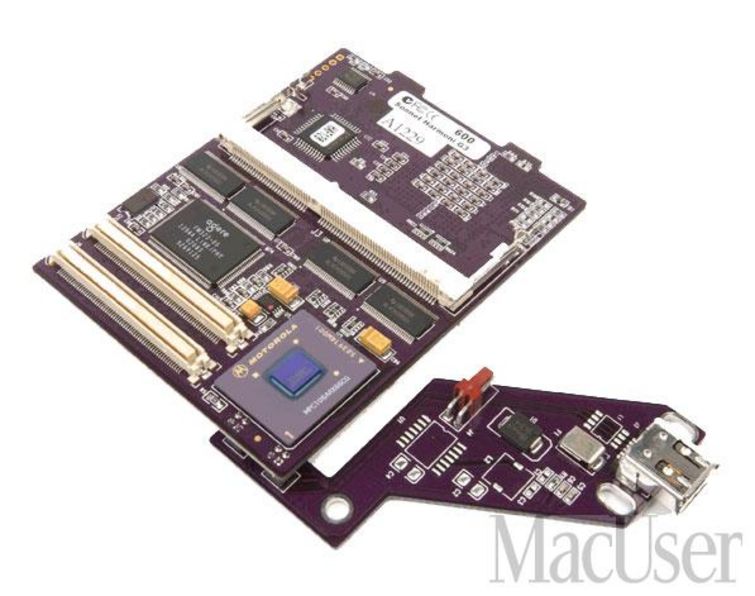
And a few more photos.
Original features:

Information:
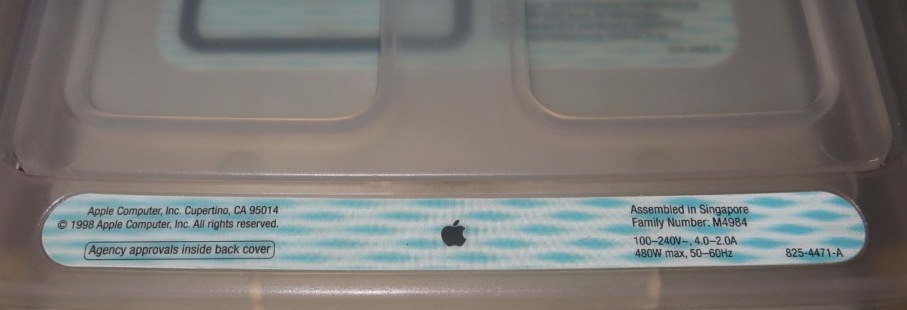
General form:
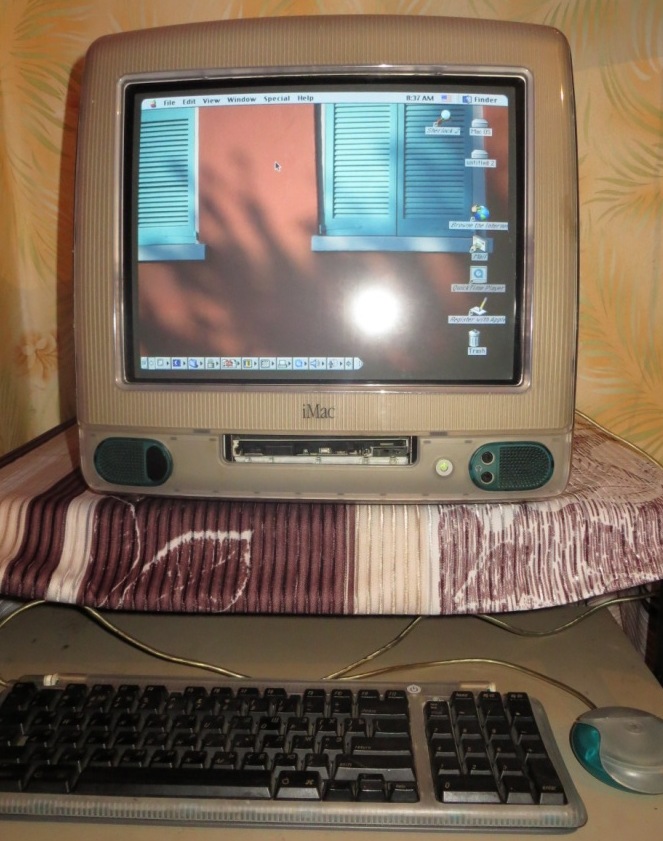
Operating system:

If the habrasoobshchestvu will be interesting, during the week I can make a review of MacOS 9, MacOS X 10.3.9 and Linux on this iMac, as well as an overview of some programs and games with a bunch of screenshots.
I tried to prevent spelling mistakes, for punctuation I ask for forgiveness, there was trouble with her at school.

In 1996, when Apple steadily rolled into the abyss, it was decided to seek salvation in the form of other companies with unique innovative developments. The choice was between Be Inc. and NeXT Software Inc. The Be deal failed because Jean-Louis Gassier requested $ 200 million while Apple counted on only $ 125 million. The Apple company had no choice but to negotiate the purchase of NeXT. The transaction took place and the decision of the board of directors Steve Jobs became the CEO of Apple. Remarkably, in 1985, Gassier replaced Jobs who had left Apple as the leader of the Macintosh division. Thus, both bidding firms were founded by people from Apple.
Rising at the helm of Apple, Jobs began an aggressive policy of leading the company out of crisis. One of the measures was the development of a fundamentally new Macintosh, not like previous generations. As a result, this wonderful, once cult computer appeared, which was the personification of style, convenience and quality in the world of high technologies. It was that fresh breeze that blew away the bored gray and square of previous generations of Macintoshes.
')
So, the computer that many probably saw in youth or childhood in pictures, the original iMac, was produced only in a dark turquoise color, with an opaque body. In the future, the body was made transparent, and the color palette expanded significantly. The original iMac was equipped with a motherboard of one of two revisions - A and B. The difference was in the maximum amount of RAM that could be installed, a more powerful video chip and more video memory in revision B. Also, one of the main differences from other generations of the iMac was the CD- ROM. It was a conventional laptop drive with a sliding disc tray. Subsequent versions were equipped with drives with a slot-loading disk.
External solutions
The design of this computer was developed by Jonathan Ive. It has rounded smooth shapes, almost no sharp lines are observed anywhere. The lower part of the monoblock is made of translucent gray plastic. The front panel is made of the same plastic, only with the addition of vertical edges. The upper part of the case is also made of a dark turquoise translucent plastic. On top there is a ventilation grille, in the middle of which is mounted a handle for carrying a computer. By the way, it is very useful, since the iMac weighs almost 16 kg. In addition, on eBay, you can order a glass tabletop, which will turn the iMac into an original table.

IMac has some interesting solutions. For example Foldable leg, which allows you to raise the computer if it is too low.
With leg:

Without legs:

Also, an interface block is made interesting. It is closed with a hinged lid with a hole into which the wires are passed. In subsequent versions of iMac, the connector panel is completely open.

My copy came into my hands from the owner of one small Krasnoyarsk printing house, in which it had previously been used for layout and has recently done color matching (not strong in terms, but the former owner explained this). I found it on some bulletin board. I phoned the seller and went to Krasnoyarsk. Having met at the Opera and Ballet Theater, he gave the owner 1,500 ever-wooden ones, which he asked for a box with a computer, and went home with the purchase. I must say that the purpose of the purchase was pretty stupid - to feel the technique of Apple, which is so much praised. In my city to work on a poppy and even more so to buy Apple products was not possible. Then I decided to fuck eBay. I even stopped at one iMac G4 (iLamp) but stopped the cost of delivery, which was twice its price.
A little familiar with the appearance, you can look inside.
Iron
iMac is a monoblock, in the upper part of which are located: a kinescope, a video signal processing board and a power supply unit. At the bottom are: motherboard, optical drive, hard drive, speakers, infrared. The top and the bottom of the monoblock are separated by a metal mesh partition, which serves as a screen protecting the motherboard from interference and interference from the power supply and scan modules.
Access to electronics is closed by a plastic translucent cover, which is held by one screw (I did not have one). It is removed quite nontrivially and noisy.

It is necessary to take the handle and pull up and back. With a loud sound, the cover is separated from the case and remains hanging in the hand. We remove it.
The computer part of the iMac is located in a sort of cup-sled which, after unscrewing the two screws and disconnecting the plugs, is pushed back.
Let us consider the result of the preparation.
Below we see the CD-ROM, just above, in fact, the motherboard.

Here you can see the graphics chip Ati Rage IIc and 2MB SGRAM soldered on the board, the white SO-DIMM connector is designed to expand the amount of video memory with the SO-DIMM SGRAM bar. In total, you can have up to 6MB of video memory.

Next, you can consider the Crystal 4211 sound processor, a Li-ion battery for saving OpenFirmware parameters, and a FireLink network controller.

RAM
Well, the most important part - the processor and RAM. The radiator has already been removed from the processor. Next, as I understood it, the cache is soldered, if not, correct it. It is characteristic that the processor and RAM are on a separate board that “sits” on the motherboard. Memory slots are located one on each side. Just above the processor, you can see the 256MB SO-DIMM SDRAM module.

For reasons unknown to me, he sees it in half. Initially, there were 2 modules of 64MB in it, however, he saw 96MB. Experienced by, I found out what bar he sees completely and which half. When I bought the bar at 256MB I really hoped that she would see her completely. However, my hopes were broken when I saw in the information about the poppy that 128MB RAM is available. Then I added a 64MB bar to the second slot which was completely visible. Total out 192 MB. MacOS 9 just flew even at 96MB, and even on such a volume ... However, when preparing the article, it turned out an unpleasant detail. When turned on, the poppy issued a heart-rending creak from the speakers and refused to start. I was really upset that my little son was flooded with something, but later I tried to take out one memory module. Unfortunately, it turned out that this 64MB bracket had died and was replaced by a 64MB module but which is seen in half. Total now it has 160 MB of RAM. In principle, you can run MacOS X10.3.9, but it crawled leisurely, even with 192 MB of RAM.
Dead cause for confusion.

CPU
The processor is Motorola XPC750, model 750 PowerPC architecture, with a clock frequency of 233 MHz. Cooled by a small aluminum radiator.


View of the motherboard without a processor card

Drives
The hard drive was originally a 4GB Quantum Fireball, and with it I got the poppy. However, a month later I noticed a strong inhibition and freezes. And after a while I tried to reinstall the OS, and the installation hung when accessing the disk. To confirm my suspicions about the hard drive, I checked his MHDD on another machine. No matter how sad, but instead of gray cubes crosses stubbornly fell on the table. I had to get out of the bins of the old Seagate 40GB.

And here is the CD-ROM, judging by the label, it was made by Apple, according to Apple specifications for Apple. In fact, released by Matsushita.

At the end of the drive tray should be a cap in the color of the case. There is a cap, but I could not find it after my son got access to the iMac.
Now, when plenty of admire the inside, you can assemble a computer and turn it on.
Assembly
We return the computer part to the former view:

View of the case without a computer part. The fan is the only one in the whole structure. It blows the processor module, drawing in air through the lower lattice of the case, and blows it into the upper part, thus cooling also the power supply unit with the monitor.


The wires from the top of the withdrawn through the rubber ... bushings, that is.


All assembled. It remains only to wear a cap.

Interfaces
The interfaces for the original iMac are as follows (from left to right):
Microphone jack, headphone jack, two USB1.1 jacks, network adapter jack, hidden “cold reset” buttons and, if the OpenFirmware settings reset memory does not change me. And the extreme right is the telephone line jack for the internal modem, which by the way is V.92, which is very good for those years. The cap at the bottom was supposed to be a SCSI connector, but apparently changed their mind at the last moment.

As many probably noticed, there is no FireWire port. On subsequent versions, it has already been entered. However, there was an unofficial way to screw the FireWire port to the original iMac, for the subsequent installation of MacOS X 10.4 - the Harmoni card-accelerator. It had a FireWire controller, a faster G3 500 processor and slots for RAM. It was installed instead of the standard processor board. However, to find it now is unreal.

And a few more photos.
Original features:

Information:

General form:

Operating system:

If the habrasoobshchestvu will be interesting, during the week I can make a review of MacOS 9, MacOS X 10.3.9 and Linux on this iMac, as well as an overview of some programs and games with a bunch of screenshots.
I tried to prevent spelling mistakes, for punctuation I ask for forgiveness, there was trouble with her at school.
Source: https://habr.com/ru/post/208926/
All Articles